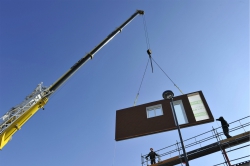Fast, affordable and trouble-free mass retrofit towards net-zero energy for social housing
Net-zero energy homes can help ensure a sustainable future that is less reliant on fossil fuels. Such homes are well insulated and energy efficient, generating sufficient renewable energy to heat the house, provide hot water and power household appliances. The aim of the TRANSITION ZERO(opens in new window) project was to establish the right market conditions for the wide-scale introduction of net-zero energy homes across Europe. The project built on the Energiesprong approach pioneered in the Netherlands, adapting this successful methodology to retrofits in France and the UK, first and foremost in the social housing sector. Current approaches to implementing energy efficiency measures for major renovations across the EU are not set to meet the ambitious 2020 targets. "Energy efficiency can't be optimised through piecemeal insulation measures and incremental steps. It has to be a whole-house retrofit approach to deal with the fundamental problems associated with hard to heat houses," notes Ron Van Erck, Transition Zero Programme Manager Europe. Energiesprong, meaning 'energy leap', aims to shift thinking in the housing refurbishment sector and deliver net-zero energy housing on an industrial scale. "An Energiesprong retrofit is about delivering affordable year-round comfort. It's a collaborative process involving three agents of change: contractors, housing providers and residents," Van Erck observes. In the Netherlands, the involvement of residents' committees in design and procurement discussions helped residents reap the full benefits of refurbishment. Warm, comfortable and affordable homes for life The first retrofit pilot projects in the UK and France involved 37 hard-to-heat homes built between 1950 and 1980. "Superb energy performance isn't just expected — it's monitored and guaranteed. For each pilot, the solution provider offers measures that will generate sufficient annual energy to heat the house, supply hot water and power basic household appliances," says Van Erck. But as the Dutch experience showed, economies of scale come with mass roll-out and volume prefabrication. Hence, the insulated wall panels used in the refurbishment are manufactured offsite and craned into position. "Typically, solution providers are wrapping the homes in a second skin made up of insulated panels constructed offsite. The heating and hot water systems are integrated into an energy module along with monitoring equipment, installed on the exterior, so access for maintenance is easy," explains Van Erck. The aim was to complete the non-intrusive retrofit within one or two weeks, without the resident having to move out, with the result being a warm, comfortable and affordable home that is modern and attractive. The Energiesprong approach uses an energy performance contract to guarantee the transition-zero.eu/wp-content/uploads/2018/06/Energiesprong-works_DEF.pdf (performance of the improvements) over a period of 25 to 40 years. Making a deal In 2017, 36 organisations — 9 social housing providers, 20 solution providers and 7 facilitating organisations — signed a charter including a collective agreement to renovate 3 600 homes in France. There are also plans to roll out retrofit to 225 homes in the UK. According to Van Erck: "When we scale this up, the whole-life income and cost savings can fund the work. Once the retrofit costs are comparable to 'business as usual', more housing providers will come on board." The entire retrofit costs per home started at around EUR 75 000 in France, but a target of EUR 45 000 is needed to deliver mass adoption. "Efficiencies of scale, through off-site assembly and automation, will cut down costs. The second-generation energy module will cost 35 % less thanks to increasing orders and a more compact design," concludes Van Erck.







